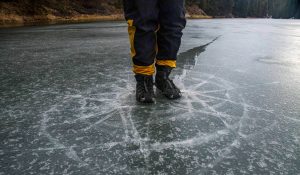Ice fishing brings a unique winter adventure, allowing anglers to access fish otherwise unreachable in warmer months. However, ensuring the ice is safe is the first priority. Testing ice thickness properly prevents dangerous situations, helping anglers stay safe while enjoying the sport. Here’s a comprehensive guide on testing ice thickness, what to look for, and tips to stay safe throughout the season.
Understanding Ideal Ice Thickness for Safety
- Walking on Ice: The general guideline is that ice should be at least 4 inches thick to support a person walking.
- Snowmobiles and ATVs: For these vehicles, ice should measure 5–7 inches.
- Small Cars and Trucks: A minimum of 8–12 inches is necessary to support small cars, while medium-sized trucks require 12–15 inches.
- Additional Precautions: Ice thickness varies based on water currents, depth, and temperature fluctuations. Regularly checking thickness in different areas reduces the risk of weak spots.

Tools for Testing Ice Thickness
- Ice Chisel (Spud Bar): This long metal tool helps create small test holes to gauge ice stability. Strike the chisel firmly into the ice; if it easily punctures, the ice may be too thin.
- Auger: Hand or power augers drill deeper holes, providing precise measurements. They’re also useful for making additional fishing holes later.
- Ice Screws and Tape Measure: Ice screws anchor to the surface for measuring depth accurately. Attach the tape measure to check exact thickness.
How to Test Ice Thickness Safely
- Start Near the Shore: Begin testing ice thickness close to shore, gradually moving to deeper areas. Ice near shorelines typically forms first and may be thicker.
- Check Regularly: Ice thickness can vary significantly across a lake, especially near currents or warmer areas. Test ice every 50–100 feet to stay safe.
- Beware of Ice Color: Clear, blue ice is strongest, while white or opaque ice indicates trapped air and weaker structure. Avoid ice that appears gray or dark, as it could indicate thinning or melting.
Safety Tips for Ice Fishing
- Always Bring a Friend: Solo ice fishing can be risky; bringing someone along provides extra security if conditions change.
- Carry Ice Picks: These small tools are essential in case of a fall-through, allowing for grip and leverage to pull out of the water.
- Check Weather and Local Reports: Always consult recent weather conditions and local reports on ice quality, especially after warmer days or heavy snowfall.
What to Avoid When Ice Fishing
- Avoiding Snow-Covered Areas: Snow insulates the ice, slowing its thickening and potentially masking thin spots.
- Staying Away from Moving Water: Avoid areas with streams, currents, or inflow from springs, as ice tends to be thinner and less stable in these areas.
- Ignoring Cracks or Fractures: Visible cracks or surface fractures indicate instability. Listen for cracking sounds, which can signify dangerous conditions.
Testing ice thickness is crucial for a safe ice fishing experience. By using the right tools and staying vigilant, anglers can minimize risks and make the most of their time on the ice. With the right precautions, ice fishing remains a rewarding winter pastime, connecting anglers to the thrill of the cold and a unique fishing adventure.
Image:





